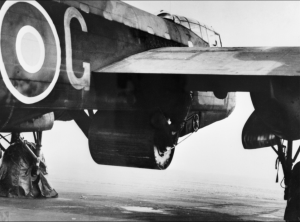In the first article titled “What to believe” I looked at the difficulty in verifying some of the facts of history. The claims made during the Battle of Britain were a useful vehicle for making the point. The theme began development somewhat earlier when I picked up a second-hand book.
“Dambusters Away” written by Jack Holsgrove, was published in 1998. The author claims that he had a pivotal role in the success of Operation Chastise, better known as the Dam Busters raid. The events that he described were completely unknown to me.
My imagination about the Dams raid (16/17 May 1943) was captured whilst at school. The 1955 film was probably the catalyst for my lifelong interest. I have read extensively. I started with Paul Brickhill’s book “The Dam Busters”. This was followed by Guy Gibson’s autobiographical account “Enemy Coast Ahead”. More recently I have read books by Alan Cooper, Max Arthur, John Sweetman, James Holland and Max Hastings. I currently have copies of the relevant books by the last three authors. There were others in the interim that I can no longer recall. Dozens of books have been published on the subject. Picking up on Napoleon’s quote, (see ‘What to believe’) a version of history has largely been agreed upon. I am left wondering whether “Dambusters Away” adds another layer to the story, or if it is a mixture of fact and fiction.
Any account of events written more than 40 years later is likely to contain errors. Dates can become mixed up. Events can be forgotten. Others can be, albeit unwittingly, exaggerated. Details become blurred. Efforts to establish the truth are complicated by the fast-diminishing pool of eyewitnesses. Move forward another 40 years and it is unlikely that there is anyone with direct knowledge of those events still alive.
There are a number of issues with Jack Holsgrove’s (JH) timeline. Two examples will serve to make the point. He says that he was posted to RAF Scampton on 14/3/1943. The problem that he was asked to solve concerned the non-release of a 10,000 pound dummy weapon that resembled a garden roller. All the other sources (see bibliography at the bottom) say that Squadron X, later to be known as 617 Squadron, had not been formed at the stage. Furthermore, the order for modifications to the Lancaster (to enable it to carry the full-sized weapon) was only made on 8th March. The first such plane was delivered on 4th April. The weight of a functional ‘bouncing bomb’ was 9,250 pounds. The concrete cylinder, as described, was definitely full size.
The trials in March and early April were conducted using wood around the cylinder to create a more spherical shape. The decision to rely on the bare cylinder was only taken on 18th April. So, what was a non-existent squadron doing trying to drop a later version of a weapon from a plane that had not yet been delivered?
The second example concerns the night of the raid. JH says that, just after looking at his watch to find that it was 03:25, he was stopped by a car whilst walking across the airfield. He says that the car contained Air Chief Marshall Sir Arthur Harris and King George VI. The signal indicating the successful attack on Möhne Dam was sent at 00:56. The Eder dam was breached at 01:54. The first of the successful attackers only landed at 03:11. I find it impossible to believe that the King was somewhere close enough to be able to turn up to greet the returning crews. At take-off, no one knew if the raid would be successful. At 03:25 they did not know how many planes would make it back to base. It might only have been three or four. Max Hastings and John Sweetman both say that Harris only left his headquarters in Grantham to travel to Scampton (35 miles away) at 04:00. The journey would have taken about an hour. Double British Summer Time was in operation in 1943. Daylight was 06:00 to 22:00 at Scampton in May. Even allowing for a full moon, at 03:25 it would have been dark, with a blackout in place. This might allow for misidentification. The King and Queen made a well-publicised visit to Scampton 10 days later, in full daylight.
Illustration: Guy Gibson’s Avro Lancaster B.III Special, ED932/G, AJ-G, “bombed up” with a Vickers Type 464 bomb. © IWM (HU 69915)
There appears to be a significant amount of ‘misremembering’ in JH’s account. If he had lived a life in the shadows, it would be easy to dismiss his claims as the work of a fantasist, a glory seeker. But this is not the case. He was a highly successful businessman. He became very wealthy. He was well respected in the community. He had nothing to gain by creating a totally fictitious narrative. A letter to JH written by Alan Sweetman on 2/2/1983 sums things up quite well. “I’m aware that, as yet, we may not have the whole story and probably never will.” This statement can be applied to almost all historical events. It neither confirms nor denies Alan Sweetman’s view of the events portrayed in the book. If we cannot be certain about the facts of such a well-documented event, what chance do family historians have?
Bibliography
Guy Gibson “Enemy coast ahead” written 1944, pub 1946
Paul Brickhill “The Dam Busters” pub 1951 ( the basis for the 1955 film)
John Sweetman “The Dam Busters Raid” pub 1990, updated 2002
James Holland “The Dam Busters” pub 2012
Max Hastings “Chastise” pub 2020
Max Arthur “Dambusters: a landmark oral history” pub 2008

